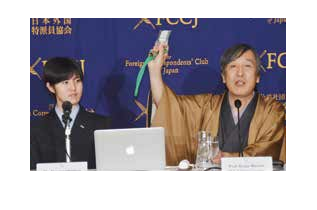Issue:
Some Tohoku high school kids began radiation monitoring of their daily surroundings – and got some surprising results.
HARUKA ONODERA MAY ONLY be a teenage high-school student, but an experiment that she initiated has convinced her that when it comes to the accident at the Fukushima Daiichi nuclear plant, scientifically proven facts trump panic-stricken proclamations that we are all doomed.
A pupil at Fukushima High School, Onodera is one of a group of students who set out to monitor their exposure to radiation in the aftermath of the crisis. With the subsequent assistance of Ryugo Hayano, a professor in the Physics Department at the University of Tokyo, the investigation took on an international dimension as students in France, Belarus and Poland were also invited to record their daily exposure levels.
In results that may come as a surprise to some, the research by the 216 students showed that the individual external doses that students in Fukushima Prefecture are currently being exposed to are “well within the terrestrial background radiation levels of other regions.”
“There have been various opinions among the students about our investigation, but the one thing that we share is the importance of basing our judgments on objective facts,” Onodera said at a February press conference at the FCCJ. “With this information, I believe that each person can evaluate their own risk and take measures,” she said. “But making a judgment based on scientific facts is the best way of improving the situation.” That is not, however, to play down the severity of the situation at the plant, 225 kilometers northeast of Tokyo, she said.
Some 160,000 people were initially forced to leave their homes within a 20-kilometer exclusion zone imposed around the plant, turning communities such as Naraha and Tomioka into ghost towns. Five years on, the government has declared its efforts to decontaminate many of the villages around the plant to be a success and is encouraging people to return.

There is understandable reluctance to trust the word of the authorities, however, which makes independent, peer-reviewed studies such as the one by Onodera, which has been printed in the journal of the Society for Radiological Protection more important.
Conducted over two weeks in 2014, students at six high schools in Fukushima Prefecture and a further six schools across the rest of Japan were issued personal dosimeters known as D-shuttles. Worn around the neck or placed beside the students' beds at night, the devices measured hourly dose rates and, combined with personal activity journals, permitted the students carrying out the study to determine hourly and total exposure to radioactivity, as well as locations where they were exposed to the greatest amounts of radiation.
On closer examination, the figures showed that Onodera was exposed to greater amounts of radiation at her home a largely wooden structure than at her school, which is made of reinforced concrete and serves to shield her. The devices were later provided to 40 students in Paris, 28 pupils in Poland and 12 in Belarus.
“The data shows that the dose rates were almost equal in all areas,” Onodera said, exhibiting the team’s research in a series of diagrams. “The results show that the distribution of the exposure is almost the same within Fukushima Prefecture as elsewhere in Japan and overseas.”
The data showed that results were similar for the extrapolated annual doses, meaning that students in Fukushima Prefecture although, significantly, the study was not able to monitor rates in the exclusion zone around the plant are exposed to the same amount of radiation as students in Nara and Kanagawa prefectures, as well as in Paris, Corsica, Warsaw and the Belarusian city of Gomel.
When a group of the European students travelled to Japan to visit Fukushima Prefecture, the dramatic spikes on their dosimeter readings were due to passing through airport security scanners and the flight to Japan.
So why, nearly five years after the disaster, are radiation levels in the vast majority of northeast Japan back within normal levels? “Mostly, this is due to the decay of cesium 134, which has a half-life of two years and was the dominant contributor in those early stages,” said Prof. Hayano. “Decontamination work must have contributed to some extent, but the decay of the cesium 134 is the biggest factor. The remaining contamination is from cesium 137, which has a half- life of 30 years, so this will be there for many more years.
“Fortunately,” Hayano pointed out, “the natural background levels of radiation in Fukushima from potassium, uranium and thorium are naturally low, so even with the added contribution from the cesium, overall levels remain at about the same level as other parts of the world.”
The professor also displayed a hint of irritation in response to a question about his optimism. “It is unfortunate that the power plant carries the Fukushima name because any time that anyone used that word, it has come to mean the power plant,” he said. “The situation there is not the same as in the high schools, the cities, the rest of the prefecture. We need to be careful how we use the word Fukushima.
“We are not declaring that the whole of Fukushima is completely safe, but I would say that people living in areas outside the 20-kilometer exclusion zone can lead a normal life,” he added.
[The study can be found at http://iopscience.iop.org/ article/10.1088/0952-4746/36/1/49]
Julian Ryall is Japan correspondent for the Daily Telegraph.

